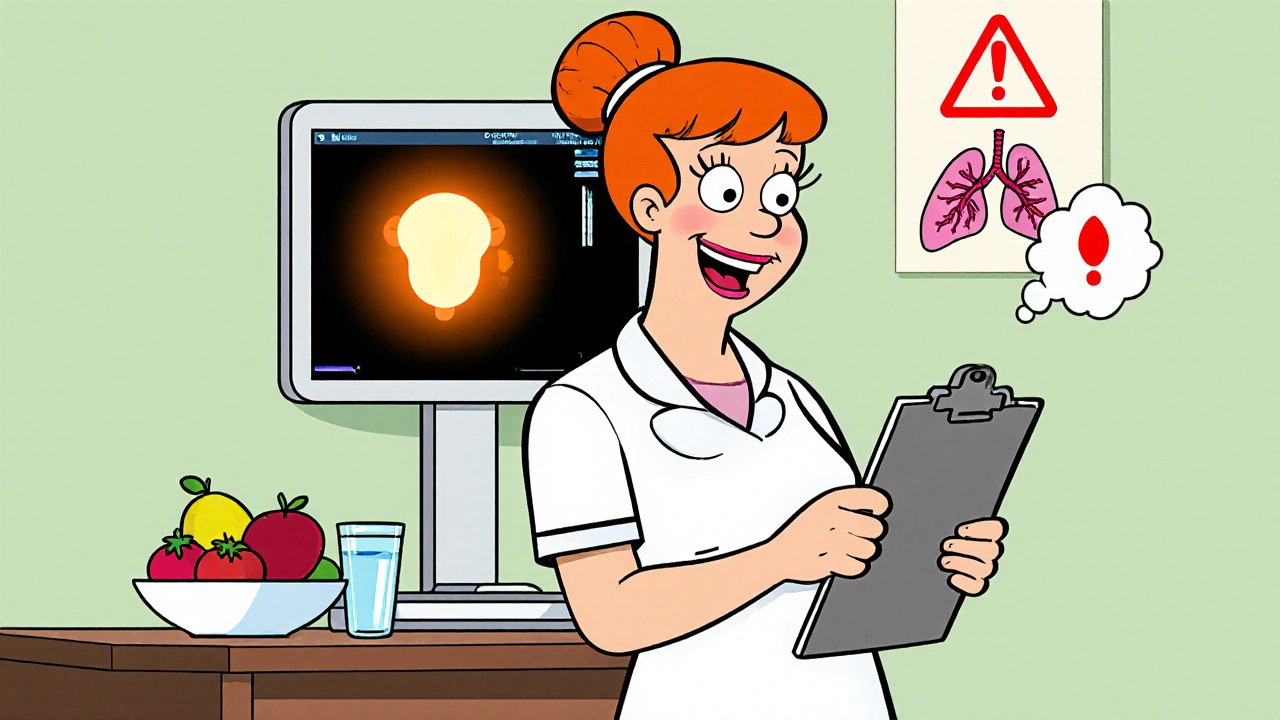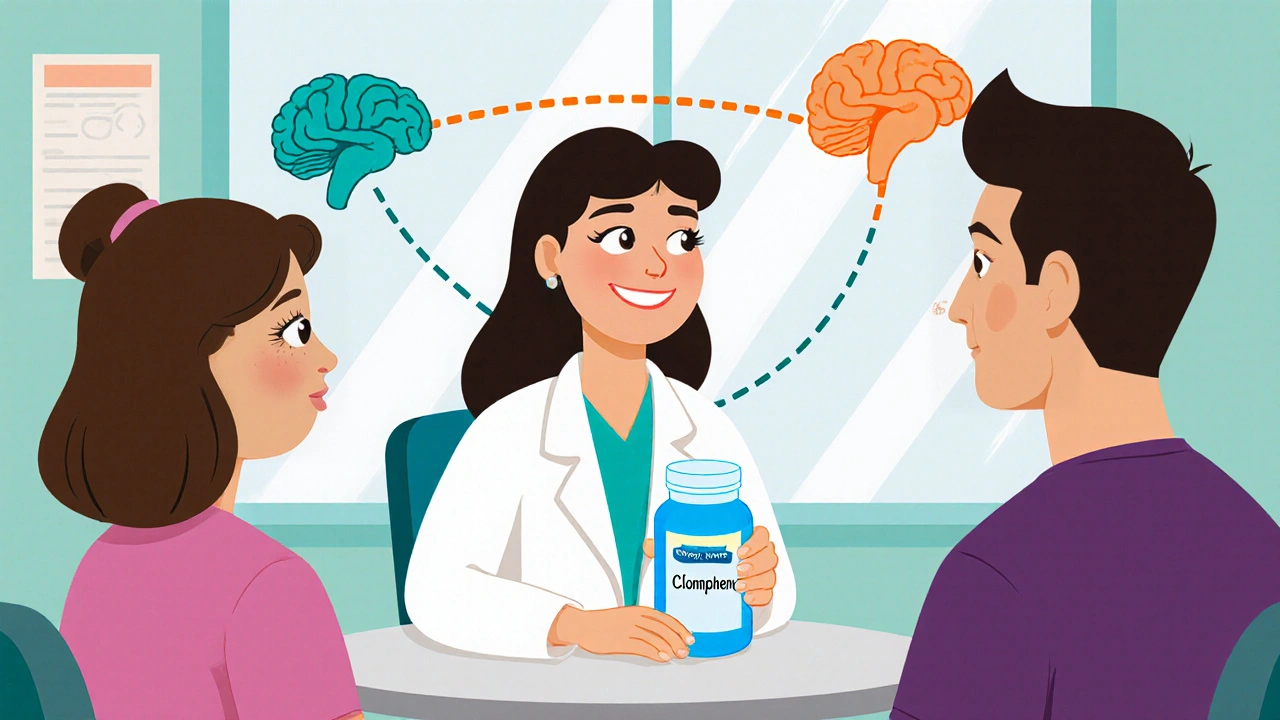When doctors prescribe Clomiphene - also known as clomiphene citrate - they’re offering a medication that nudges the body to release more eggs, boosting chances of pregnancy. Clomiphene is a selective estrogen receptor modulator (SERM) used primarily for ovulation induction in women with infertility. While it can be a game‑changer for many, the drug isn’t without trade‑offs. Knowing the clomiphene side effects ahead of time helps you weigh benefits against risks and plan for a smoother journey.
Key Takeaways
- Clomiphene works by blocking estrogen feedback, prompting the pituitary to release more FSH and LH.
- Common side effects include hot flashes, mood swings, and abdominal discomfort.
- Rare but serious reactions-such as ovarian hyperstimulation syndrome (OHSS) and blood clots-require immediate medical attention.
- Risks rise with higher doses, prolonged use, or pre‑existing conditions like PCOS.
- Regular monitoring, lifestyle tweaks, and open communication with your fertility clinic can minimize most adverse effects.
How Clomiphene Works in the Body
Clomiphene belongs to the SERM family, meaning it binds to estrogen receptors in the hypothalamus and pituitary gland. By tricking the brain into thinking estrogen levels are low, it forces the pituitary to pump out more follicle‑stimulating hormone (FSH) and luteinizing hormone (LH). Those hormones stimulate the ovaries to develop multiple follicles, increasing the odds of a successful ovulation.
The drug’s half‑life ranges from 5 to 7 days, but its active metabolites linger up to two weeks. This prolonged exposure explains why side effects can persist even after the 5‑day treatment cycle ends.
Common (Mild) Side Effects
Most women experience at least one of the following during or shortly after a clomiphene cycle. They’re usually self‑limiting and fade once treatment stops.
- Hot flashes & night sweats - A sudden wave of heat, often paired with flushing.
- Mood swings - Irritability, anxiety, or mild depression; hormone fluctuations are the main culprit.
- Abdominal bloating & pelvic discomfort - Often mistaken for menstrual cramps.
- Breast tenderness - Similar to what some experience during early pregnancy.
- Headaches - May be tension‑type or migraine‑like; hydration helps.
- Nausea or vomiting - Usually mild; taking the pill with food can reduce it.
These symptoms typically resolve within a week after the last dose. If they linger beyond two weeks, contact your clinician.

Less Common but Concerning Side Effects
These occur in a smaller fraction of users but can have lasting health implications if ignored.
- Ovarian hyperstimulation syndrome (OHSS) - Swollen, painful ovaries, rapid weight gain, shortness of breath, and fluid accumulation in the abdomen. Severe cases may need hospitalization.
- Visual disturbances - Blurred vision, spots, or light flashes; often linked to high doses.
- Thromboembolic events - Blood clots in legs (deep‑vein thrombosis) or lungs (pulmonary embolism); risk spikes in smokers or women with clotting disorders.
- Liver enzyme elevation - Mild hepatitis‑like picture; usually reversible after stopping the drug.
- Multiple pregnancies - Twins, triplets, or higher-order births; carries higher obstetric risk.
- Birth defects - Slight increase in certain anomalies when clomiphene is taken throughout early pregnancy; doctors typically stop the drug once pregnancy is confirmed.
Frequency of Side Effects
| Side Effect | Frequency |
|---|---|
| Hot flashes / night sweats | Common (30‑60%) |
| Mood swings | Common (25‑45%) |
| OHSS | Rare (1‑5%) |
| Visual disturbances | Uncommon (2‑4%) |
| Thromboembolism | Very rare (<1%) |
| Elevated liver enzymes | Uncommon (3‑6%) |

Managing and Reducing Risks
Proactive steps can keep side effects in check while preserving clomiphene’s fertility benefits.
- Baseline health screening: Blood work for hormone levels, liver function, and clotting profile before the first cycle.
- Start low, go slow: Typical starting dose is 50 mg per day for five days; increase only if ovulation doesn’t occur and no major side effects arise.
- Ultrasound monitoring: Mid‑cycle scans detect ovarian size, helping catch early signs of OHSS.
- Hydration & balanced diet: Adequate fluids and low‑sodium meals reduce bloating and may soften hot flashes.
- Avoid smoking & estrogen‑containing birth control while on clomiphene, as they heighten clot risk.
- Report visual changes immediately: Dose adjustment often resolves the problem.
- Consider adjunct therapy: Letrozole or gonadotropins may be alternatives for women who repeatedly experience severe side effects.
When to Seek Immediate Medical Attention
Even rare events can become emergencies. Call your doctor or go to the nearest emergency department if you notice:
- Sudden, severe abdominal pain or rapid weight gain (>2 kg in 24 hours).
- Shortness of breath, chest pain, or coughing up blood (possible clot).
- Blurry vision, flashes of light, or loss of sight.
- Yellowing of the skin or eyes (sign of liver trouble).
Frequently Asked Questions
Can men take clomiphene?
Yes. In men, clomiphene can raise testosterone levels and improve sperm quality, but the side‑effect profile differs-most men report mood changes and visual disturbances. A urologist should supervise therapy.
How long should a clomiphene cycle last?
Standard practice is a 5‑day course starting on day 3-5 of the menstrual cycle. If ovulation does not occur, doctors may repeat the cycle after a 2‑week break, up to six cycles total.
Is it safe to become pregnant while still taking clomiphene?
No. Once pregnancy is confirmed (usually by a positive hCG test), clomiphene is stopped to avoid potential birth‑defect risks and to reduce OHSS chances.
Do lifestyle factors affect side‑effect severity?
Absolutely. Smoking, excessive caffeine, and high‑stress environments can amplify hot flashes and mood swings. Maintaining a balanced diet, regular exercise, and stress‑relief techniques helps mitigate many mild symptoms.
Can clomiphene interact with other medications?
Yes. Anticoagulants, certain anti‑depressants, and hormonal contraceptives can change clomiphene’s effectiveness or raise clot risk. Always share a full medication list with your fertility specialist.
Understanding the full spectrum of clomiphene side effects equips you to make informed choices, catch warning signs early, and collaborate effectively with your healthcare team. With careful monitoring, most users complete their cycles without major issues and achieve the pregnancy they’re hoping for.


Kester Strahan
October 24, 2025 AT 17:08Clomiphene's mechanism hinges on estrogen receptor antagonism in the hypothalamus, which tricks the pituitary into upping FSH and LH output. This pharmacodynamic shift is what drives follicular recruitment, especially in PCOS cohorts. Keep an eye on dosage titration; higher mg’s amplify both ovulatory response and side‑effect profile.
Doreen Collins
November 2, 2025 AT 22:21Hot flashes can feel like sudden fire alarms, but staying hydrated and wearing breathable fabrics often dulls the intensity. Mood swings, while unsettling, usually settle once the drug clears the system.
Kathryn Rude
November 12, 2025 AT 04:34The clomiphene narrative is often reduced to a simple fertility enhancer, yet its pharmacology is a tapestry of endocrine modulation.
By binding estrogen receptors with selective affinity, it creates a functional estrogen deficit in the brain.
This deficit prompts the anterior pituitary to surge follicle‑stimulating hormone and luteinizing hormone, orchestrating follicular growth.
The resulting cascade can yield multiple dominant follicles, raising the statistical odds of conception.
However, the same cascade can also precipitate ovarian hyperstimulation, a condition demanding immediate clinical attention.
Women reporting visual disturbances should be evaluated for dose‑related retinal vasospasm, an uncommon but documented side effect.
The drug's half‑life extending up to two weeks means that symptomology can linger beyond the active dosing period.
Lifestyle factors such as smoking or excessive caffeine intake have been correlated with amplified vasomotor symptoms.
Regular ultrasound monitoring serves as a safeguard against excessive ovarian enlargement and potential rupture.
In the rare event of thromboembolic complications, anticoagulation therapy must be coordinated with a hematology specialist.
Nutritional adequacy, particularly adequate folate and omega‑3 fatty acids, may ameliorate mood fluctuations.
Patients should maintain a symptom diary, noting onset, duration, and severity, to facilitate nuanced therapeutic adjustments.
Communication with the fertility clinic should be proactive, not reactive, ensuring dose modifications are timely.
While multiple pregnancies are statistically heightened, prenatal care protocols can mitigate associated obstetric risks.
Ultimately, clomiphene embodies a balance of promise and peril, demanding informed consent and vigilant follow‑up. :)
Ekeh Lynda
November 21, 2025 AT 10:48Clomiphene works by hijacking the feedback loop of estrogen in the hypothalamus it forces the pituitary gland to think there is a scarcity of hormone and consequently it releases more FSH and LH which then stimulate the ovaries to produce multiple follicles this process can be beneficial for those with anovulatory cycles but it also opens the door to side effects that can be both uncomfortable and medically significant such as hot flashes night sweats abdominal bloating and mood changes the risk profile escalates with higher doses or prolonged cycles and the lingering metabolites mean that symptoms may persist well after the five day course ends careful monitoring through ultrasound and blood work is therefore essential to catch any early signs of OHSS or thrombotic events without delay
Casey Morris
November 30, 2025 AT 17:01Wow, that was an impressively thorough breakdown, and I appreciate how you connected the pharmacokinetics to real‑world monitoring, especially the emphasis on ultrasonography, which is often under‑discussed; also, the point about lifestyle modulation, like cutting caffeine, really resonates, and the reminder to keep a symptom diary is gold; great job!
Teya Arisa
December 9, 2025 AT 23:14Dear community, thank you for sharing such detailed insights; it is evident that a multidisciplinary approach-encompassing endocrinology, reproductive medicine, and patient education-optimizes outcomes. Please continue to prioritize open dialogue with your care team, and remember to schedule regular follow‑up appointments. 😊
HILDA GONZALEZ SARAVIA
December 19, 2025 AT 05:28Clomiphene’s efficacy can be enhanced by timing the start of the 5‑day course with the early follicular phase, typically days 3‑5 of the menstrual cycle. Dosage escalation should proceed in 50 mg increments, monitoring ovulation via mid‑cycle LH surge testing. Patients with a history of thromboembolic disease may require alternative agents such as letrozole. Adequate hydration and balanced nutrition support metabolic clearance of the drug’s metabolites. Always discuss any concomitant medications, especially anticoagulants, with your specialist.